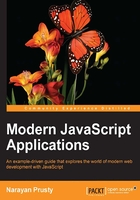
Chapter 2. Building a Coupon Site
The best way to understand Seneca and microservices architecture is by building a server-side application that would benefit from the microservices architecture. In previous chapter, we saw how large and complex server-side application benefits from the microservices architecture and why enterprises use microservices architecture. In this chapter, we will build a coupon website to practically demonstrate the benefits of using microservices architecture and Seneca to create a server-side application. While building this coupon site, you will also learn how to design a server-side application using the microservices architecture from scratch, how to split the functionality of the application into services, how a client can directly communicate with the services, and many other things.
Some of the things that we will cover in this chapter, apart from things related to Seneca and microservices architecture, are as follows:
- Using the
seneca-mongo-storeplugin to store data in MongoDB - Creating a basic image storage server
- Discussing HTTP basic authentication using the basic-auth npm package
- Using the connect-multiparty npm package to parse HTTP POST requests with the
multipart/form-datacontent type - Moving, deleting, and renaming files in Node.js using the
fsnpm package - Implementing pagination with MongoDB and Express